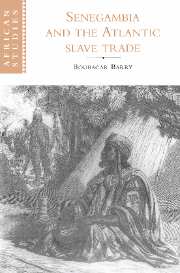Book contents
- Frontmatter
- Contents
- Preface
- Map
- I Senegambia from the fifteenth to the seventeenth century: a haven for incoming populations, a station for migrants on the move
- II Senegambia in the eighteenth century: the slave trade, ceddo regimes and Muslim revolutions
- III Senegambia in the first half of the nineteenth century: legitimate trade and sovereignty disputes
- IV Senegambia in the second half of the nineteenth century: colonial conquest and resistance movements
- 14 Colonial imperialism and European rivalries in Senegambia
- 15 Last-ditch resistance movements of legitimist rulers in northern Senegambia
- 16 The conquest of the Southern Rivers region
- 17 The balancing act of the Almamis of Timbo in their attempts to cope with centrifugal forces
- 18 Bokar Biro and the conquest of Futa Jallon
- 19 Mass resistance movements among the Joola and the Konyagi
- Conclusion
- Notes
- Bibliography
- Index
- Other books in the series
19 - Mass resistance movements among the Joola and the Konyagi
Published online by Cambridge University Press: 31 October 2009
- Frontmatter
- Contents
- Preface
- Map
- I Senegambia from the fifteenth to the seventeenth century: a haven for incoming populations, a station for migrants on the move
- II Senegambia in the eighteenth century: the slave trade, ceddo regimes and Muslim revolutions
- III Senegambia in the first half of the nineteenth century: legitimate trade and sovereignty disputes
- IV Senegambia in the second half of the nineteenth century: colonial conquest and resistance movements
- 14 Colonial imperialism and European rivalries in Senegambia
- 15 Last-ditch resistance movements of legitimist rulers in northern Senegambia
- 16 The conquest of the Southern Rivers region
- 17 The balancing act of the Almamis of Timbo in their attempts to cope with centrifugal forces
- 18 Bokar Biro and the conquest of Futa Jallon
- 19 Mass resistance movements among the Joola and the Konyagi
- Conclusion
- Notes
- Bibliography
- Index
- Other books in the series
Summary
The Joola and Konyagi peoples lived far from the main axes of colonial conquest. They were therefore practically the last groups in Senegambia to face the French. On account of their egalitarian social structures, they were able to mobilize unsuspected energies in the defense of their independence right up until the early twentieth century. The first attempts at colonial penetration into Joola territory go back to around 1850, when Bocandé built a post at Karabane to keep the British and the Portuguese out of the Lower Casamance basin. But the French first consolidated their footholds in the Middle and Upper Casamance basins, where peanut farming was a major activity. Only in the 1880s, when rubber began to attract trading companies, did they begin clamoring for the conquest of the Lower Casamance basin. The colonial regime then ran into a popular, village-based resistance movement that effectively helped the area's inhabitants retain their independence until the outbreak of World War I.
The Lower Casamance Joola, relying on the inaccessibility of their villages, refused to submit to the French authorities. The latter organized expeditions to try and subdue the Karone or Bayot communities. But the people organized their resistance village by village, refusing to cooperate with the Wolof chiefs imposed by the colonial regime, while doing their best to avoid paying taxes on rice, their staple food.
- Type
- Chapter
- Information
- Senegambia and the Atlantic Slave Trade , pp. 294 - 302Publisher: Cambridge University PressPrint publication year: 1997



